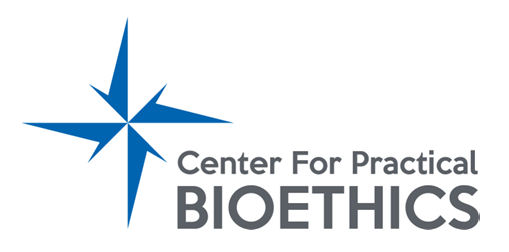Ethics Dispatch August 2025
“Functioning as our better selves leads to better outcomes for patients and everyone.”
Tarris (Terry) Rosell, PhD, DMin, HEC-C
By Ryan Pferdehirt, D.Bioethics, HEC-C, Vice President of Ethics Services, Rosemary Flanigan Chair
& Cassie Shaffer Johnson, MA, Program Coordinator
HOT TOPIC
When Caring Becomes Dangerous:
Ethics of Healthcare Workers Facing Patient Violence
Violence toward healthcare workers is becoming more frequent and more severe. In light of recent deadly attacks on the CDC by political extremists and the increasingly common reports of gunmen opening fire in hospitals of all sizes, it is crucial to examine the ethical dilemmas healthcare workers face amid heightened threats and radicalized rhetoric. This escalating hostility targets not only healthcare workers, but also scientists and researchers, further fueling the flames of violence.
Studies show that up to 38% of clinicians have experienced physical assault on the job, and verbal abuse is even more common. Nurses and frontline staff bear the brunt of this growing wave of hostility, facing risks that extend far beyond the usual emotional toll of caregiving.
Recent changes to coverage – such as shifts in Medicaid and other public benefits noted in the July Dispatch – are compounding pressures, increasing the likelihood of patient frustration, delays in care, and volatile encounters. At the same time, unfounded anti-medicine and anti-science rhetoric from radicalized, attention-seeking public figures fuels a dangerous climate, emboldening their followers to disrespect, undermine, and even antagonize the very professionals who have devoted their lives to healing. These conditions raise an urgent ethical question: How much risk should we expect healthcare workers to take on for the sake of their patients, especially when those same patients pose a threat?
Competing Factors
A recent article by Pilcher and colleagues in AMA Journal of Ethics examines this tension and offers a framework for ethical decision-making in the face of patient violence. Their approach highlights the competing values at play: the longstanding professional duty to care for patients, and the equally important obligation to protect staff from harm. These two priorities are not always easy to balance.
Clinical urgency is one important factor. Pilcher et al. point out that when a patient’s life is at risk, the ethical duty to provide care is especially strong – even in the face of aggressive or violent behavior. But when care is non-urgent, healthcare workers may be justified in pausing or modifying treatment to protect themselves. Similarly, patient decision-making capacity matters. A patient acting violently due to delirium, dementia, or severe psychiatric illness may not be fully responsible for their behavior, and that alters how clinicians ethically respond. In some cases, temporary sedation or environmental modifications may allow care to continue safely. On the other hand, if a fully capacitated patient is repeatedly threatening staff, institutions may need to draw firmer boundaries.
These ethical tensions reflect core principles in bioethics: beneficence (doing good for the patient), nonmaleficence (avoiding harm – including to the clinician), autonomy (respecting patients’ choices), and justice (ensuring fair treatment for both patients and staff). Pilcher and colleagues explore these values in depth, noting that responses to violence shouldn’t just be clinical or disciplinary – they should also reflect an understanding of trauma, human behavior, and institutional responsibility.
Institutions Set the Tone
Healthcare institutions play a crucial role in setting the tone and structure for ethical responses. One-time training sessions aren’t enough. Hospitals should provide all staff with education in de-escalation techniques and trauma-informed care, so they can respond to agitation or threats in ways that reduce the risk of escalation. Behavioral response teams can provide rapid support when a patient becomes aggressive. These teams can also help develop policies that are ethically grounded, equitable, and tailored to the complexities of hospital settings.
In addition, violence in healthcare settings doesn’t affect all staff equally. Women, nurses, early-career staff, and employees from historically marginalized backgrounds often experience more frequent and more severe violence. Institutions must be mindful of upholding the principle of equity by understanding how bias may shape both perceptions of threat and responses to it. For example, a Black patient’s frustration may be more quickly labeled as “aggressive,” while threats against a nurse of color may be minimized or dismissed. Ethical responses must account for these dynamics to ensure that all staff are protected and supported.
Balancing Duties
Addressing patient violence is not just about protecting individuals – it’s about protecting the culture of healthcare itself. Unaddressed violence leads to burnout, moral injury, and attrition. Staff who don’t feel safe are less able to provide compassionate care, and patient outcomes suffer as a result. A safe environment for healthcare workers is a necessary foundation for quality care.
There is no one-size-fits-all solution. Every incident involves different levels of risk, urgency, and context. But the guiding principle is clear: ethical responses must balance the duty to care for patients with the duty to protect the well-being of healthcare workers. That balance requires institutional support, thoughtful training, and a willingness to adapt based on the real and present risks that staff face each day. Violence in healthcare settings is not just a safety issue – it’s an ethical issue. And how we respond says as much about our values as any policy or procedure we put in place.
Sources:
BIOETHICS IN THE NEWS
CASE STUDY: Behavioral Issues Lead to Challenging Discharge
Mr. Ankeal Has a History of Threatening Behavior
Mr. Ankeal is a 44-year-old male with end-stage renal disease (ESRD) and multiple other chronic conditions, including chronic pain. He has been on hemodialysis for eight months but has struggled significantly with the treatment. Estranged from his family and without close friends, he has been moving between outpatient dialysis centers for several months due to repeated behavioral issues.
Recently, at one clinic, he threatened several members of the nursing staff and threw empty soda cans. This behavior mirrors incidents at other facilities from which he has been dismissed. He is always apologetic after these outbursts, explaining that his pain causes him to act out.
During his current hospital admission, however, his demeanor has been markedly different. He has been polite, engaging in friendly conversation with staff, and there have been no complaints about his behavior. Mr. Ankeal reports that his pain is better managed in the hospital, which helps him “keep his spirits up.”
Although he is now medically cleared for discharge and has no clinical reason to remain hospitalized, the care team has been unable to find an outpatient dialysis clinic willing to accept him due to his documented behavioral history. Staff members are willing to write letters attesting to his improved behavior during this admission, but the clinics contacted so far have declined to accept him. The team is now uncertain how long he should remain in the hospital.
ETHICAL MUSINGS
Considering Intention in Responding to Behavior
The moment makes the man. Cometh the hour, cometh the man. Both of these expressions tap into a key concept, often highly valued in Western civilization: the idea that the truest insight into a person comes from how they act in challenging moments.
We often praise the hero – the one who can remain calm in a crisis, think clearly, control their behavior, and avoid acting in any unbecoming way. Think Gary Cooper. This notion suggests that it is the moment that reveals a person’s true character, rather than the person’s ordinary presentation. It creates an enduring association between circumstance and the deeper moral fiber of an individual.
Virtue Ethics, Deontology or Consequentialism
Virtue ethics is the ethical system that analyzes the moral character of the individual performing the action, rather than the action itself. Deontology determines the value of an action based on its adherence to rules or duties, while consequentialism bases value on results. The key distinction lies in intention.
Virtue ethics holds that a person must not only do the right thing, but also do it for the right reasons. This is a robust ethical system, often utilized in subtle ways. For instance, when defending oneself against a criminal charge, it is common to bring forward character witnesses. These individuals do not explain the act itself but speak to the character of the accused – because a good person who makes a mistake is judged differently than a bad person committing the same act. The law also incorporates the role of intention, distinguishing between an accident and a premeditated act. The concepts of intention and moral character are closely linked.
A Personal Story
Healthcare is an extremely challenging profession – physically, mentally, and emotionally. Healthcare workers put their own well-being at risk to care for those in need. They witness some of life’s most difficult moments, when people are under immense strain. And people can act in regrettable ways during these times.
I can speak from personal experience, having had end-of-life conversations with patients and families. People may say or do things in their weakest moments that do not truly reflect who they are. I have been called terrible names, threatened with physical violence, and even had objects thrown at me. I recall one family who spent over an hour directing verbal abuse toward me, and yet I stood there, responding with empathy and respect. I understood the grief they were experiencing – losing their mother at a young age.
When the consultation ended, I politely said goodbye and left the room. Almost immediately, a family member followed me into the hallway and embraced me. She was an aunt who told me how important my presence had been. She explained that her niece needed someone to yell at as an outlet for her grief, and I had given her that chance. I replied that I knew her words came from the moment, not from who she truly is.
No Violence, No Judgement
It should go without saying that violence is never the answer and should never be tolerated. Healthcare workers should not have to endure any form of violence – physical or verbal.
But it is worth understanding where such behavior originates. It is not always the mark of a “bad” person; it may come from someone in deep distress, struggling with their own illness or the illness of a loved one. Healthcare workers should never be placed in danger, but they should also be careful not to judge too quickly.
Written By Ryan Pferdehirt, D.Bioethics, HEC-C, Vice President of Ethics Services, Rosemary Flanigan Chair & Cassie Shaffer Johnson, MA, Program Coordinator





